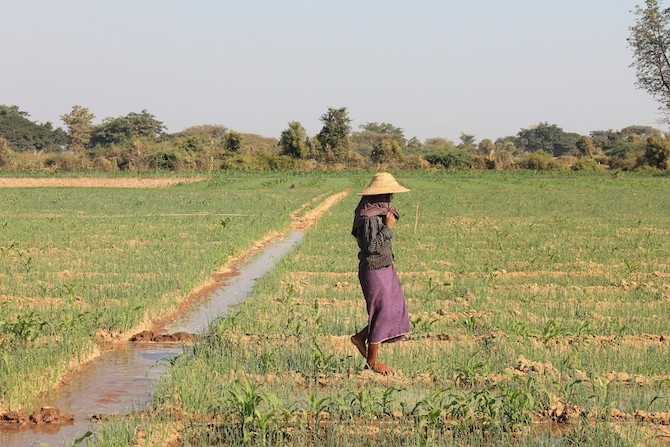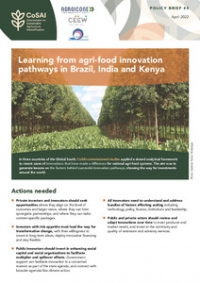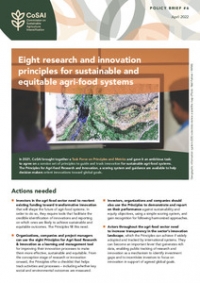It seems obvious: if it’s called the Dry Zone it must be dry. Right?
Located in a central plain, sandwiched by highlands to the east and west, the Dry Zone of Myanmar is the driest part of the country. Mean annual rainfall, ranges from 500 to 1,000 mm. This compares to values that range from 2,000 to 5,000 mm throughout the rest of the country.
 A small-holder irrigation scheme in the Dry Zone of Myanmar. Photo: Matthew McCartney/IWMI
A small-holder irrigation scheme in the Dry Zone of Myanmar. Photo: Matthew McCartney/IWMIHome to a population of approximately 14.5 million people (34% of the population of the country), the Dry Zone is the most water stressed region of the country. Limited water, for agriculture and domestic use, is widely acknowledged to be a key constraint to development and a hindrance to livelihoods and peoples’ wellbeing. Approximately 43% of households in the region live in poverty and it is one of the most food insecure areas in the country. Malnutrition in children under five years old averages approximately 8% and child mortality, at a rate of 38 per 1000 live births, is unacceptably high.
Still, despite appearances, is lack of water really the problem?
Water scarcity is typically determined by looking at water availability per head of population, and is often rated on a somewhat arbitrary 3-point scale.
- Water Stress: annual water supplies, that is water in rivers and groundwater, drop below 1,700 m3 per person (i.e. approximately two-thirds the volume of an olympic swimming pool)
- Water Scarcity: annual water supplies drop below 1,000 m3 per person
- Absolute water scarcity: annual water supplies drop below 500 m3 per person
A recent water resource assessment by the International Water Management Institute confirmed that by far the largest water source in the Dry Zone is the Irrawaddy River, which flows through it from north to south. Several large tributaries join the Irrawaddy in the Dry Zone and the total mean annual flow is estimated to be 365 km3. By any reckoning this is a vast amount of water: approximately 4 times the volume of water stored, when it is full, in Tonle Sap, Southeast Asia’s largest lake.
By comparison, the annual renewable groundwater resource is small, estimated to be just under 5 km3. But still, this means the combined surface water and groundwater available annually is approximately 370 km3. For the Dry Zone, this equates to an average availability of 25,515 m3 per person per year. This is comparable to values in water “rich” countries such as Finland, Sweden and Malaysia, and clearly hugely in excess of levels typically associated with water stress.
The Variability Curse
So, it turns out the Dry Zone is actually pretty wet and, on a global scale, water abundant. Then why does it seem dry and why is the lack of water seemingly such a constraint to agriculture and livelihoods?
The answer is of course “the curse of variability”: it is temporal and spatial variability in water resources, and insufficient capacity to manage that variability, that lies behind much of the prevailing poverty and food insecurity.
In most years, rainfall and river flows coincide with the southwest monsoon, which typically lasts from May to October. As a result, 90% of rainfall and more than 80% of river flow typically occurs within these months. At other times of year, rainfall is negligible and many streams and rivers run dry.
Many villages depend on small dams, communal ponds and shallow hand-dug wells for their water, and these also often dry up before the end of the dry season. Still, the presence of several large irrigation schemes located close to the banks of the rivers, is a testament to the fact that the Irrawaddy and its major tributaries, continue to flow with considerable volumes of water throughout the dry season.
Hence, in reality the problem is not lack of water, but rather inadequate access to water, arising as a consequence of insufficient water storage, high costs of pumping, and lack of infrastructure in areas remote from the major rivers. The inability to manage variability is the greatest constraint to a vibrant agricultural sector in the Dry Zone and the reason why, in the dry season, many households struggle to get sufficient water even for domestic needs.
What can be done?
Across the Dry Zone, better water management and improving dry season access to water are the key to reducing risk, stabilizing agricultural productivity and increasing the resilience of households. A strategic water resources plan is essential to guide water resources investment in the future and avoid the piecemeal, non-sustainable development that has occurred in the past.
Detailed studies to ascertain irrigation efficiency and water productivity in existing formal irrigation schemes and to determine opportunities for improved operation, would provide useful information to support the development of such a strategy.
Groundwater has a role to play, but care is needed since currently there is relatively little information about the locations, depths and extent of suitable aquifers, and problems with salinity and arsenic occur in some places. Investment in rainwater harvesting and small reservoirs can make a substantial contribution to safeguarding domestic supplies and crop yields, and can also provide water for livestock.
However, too often in the past these have failed to deliver long term benefits because embankments have collapsed in floods and, after a few years, reservoirs have filled with sediment washed in from upstream. Consequently, if they are to be sustainable, rainwater harvesting structures and small reservoirs must be constructed in combination with soil and water conservation measures that reduce flood runoff and erosion.
A coherent strategy to guide water resources investment in the future, would provide the basis for turning the Dry Zone green, enabling it to become the food basket of Myanmar. Who knows, with the implementation of such a plan, one day the Dry Zone might be recognized for what it really is: the Wet Zone!














Comments
what is UN & international community doing?.
How to reconcile the needs for productivities of the African rural populations and the impact strength of the watery ecosystems? Here a problem wich I try to slove on the level of the small dams in the Volta basin (Burkina Faso, West Africa)
There are many agricultural techniques that can help in this scenario. A very flexible, low cost solution would be increasing the water holding capacity of the soil to help pull crops through the most severe drought periods. increasing soil organic matter (SOM) by 1% can increase your moisture holding capacity by 17,000L's/ha. Increase SOM, CEC, and soil aeration by using products like Humalite: https://www.blackearth.com/blog/bid/352170/When-Every-Drop-of-Water-Counts